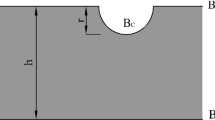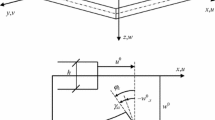Abstract
Plates are common structural elements of most engineering structures, including aerospace, automotive, and civil engineering structures. The study of plates from theoretical perspective as well as experimental viewpoint is fundamental to understanding of the behavior of such structures. The dynamic characteristics of plates, such as natural vibrations, transient responses for the external forces and so on, are especially of importance in actual environments. In this paper, we consider natural vibrations of an elastic plate and the propagation of a wavepacket on it. We derive the two-dimensional equations that govern the spatial and temporal evolution of the amplitude of a wavepacket and discuss its features. We especially consider wavenumber-based nearly bichromatic waves and direction-based nearly bichromatic waves on an elastic plate. The former waves are defined by the waves that almost concentrate the energy in two wavenumbers, which are very closely approached each other. The latter waves are defined by the waves that almost concentrate the energy in two propagation directions and two propagation directions are very close each other. The fact that the solution of the governing equation for wavenumber-based nearly bichromatic waves is stable is also shown.
Similar content being viewed by others
Abbreviations
- A:
-
slowly varying amplitude in space and/or time of a wavepacket
- Cl :
-
the function space consisting of functionsf(x) which is lth differentiable at any point ofx and the lth derivative off is continuous
- D:
-
plate flexural rigidity
- E:
-
elastic modulus
- G:
-
direction-based spectrum of a wavepacket or Green’s function
- H:
-
value used in boundary conditions
- L:
-
linear operator defined by Equations (A.19) and (A.20) or value used in boundary conditions
- M:
-
positive integer
- N:
-
positive integer
- O:
-
function of order
- Q:
-
function defined by Equation (A.18) or Fourier coefficient
- R:
-
real space
- S:
-
function used by the method of separation of variables in Equation (A.3)
- U:
-
function used by the method of separation of variables in Equation (A.3)
- a:
-
cosθ0
- b:
-
sinθ0
- c:
-
Fourier coefficient
- cc:
-
complex conjugate
- f:
-
function of initial condition
- h:
-
plate thickness
- i:
-
imaginary unit or unit vector alongx axis
- j:
-
unit vector alongy axis
- k:
-
wave number
- m:
-
integer
- n:
-
integer
- t:
-
time
- u:
-
function
- v:
-
function
- v:
-
velocity of envelope surface
- w:
-
plane traveling waves
- x, y:
-
rectangular coordinate system
- Ψ:
-
function used by the method of separation of variables in Equation (A.9)
- Φ:
-
function used by the method of separation of variables in Equation (A.9)
- α:
-
coefficient in Equation (A.34)
- β:
-
coefficient in Equation (A.34)
- γ:
-
coefficient in Equations (A.10) and (A.11)
- δ:
-
Delta function
- ε:
-
order of time and spacial scales
- θ:
-
propagation direction
- λ:
-
separation constant
- μ:
-
separation constant
- ν:
-
Poisson’s ratio
- ρ:
-
mass density
- ω:
-
angular frequency
- δD :
-
boundary of rectangle
- ∇4 :
-
biharmonic operator
- 0:
-
dominant value
- 1,2:
-
number of function or value
- m:
-
number of coefficient
- n:
-
number of function or coefficient
- ’:
-
differentiation with respect to wave numberk
- ∼:
-
modified value
- ∧:
-
modified value
- *:
-
adjoint operator
References
S. P. Timoshenko, Theory of Plates and Shells. McGraw-Hill, New York, 1940.
S.P. Timoshenko and S. Woinowsky-Krieger, Theory of Plates and Shells. McGraw-Hill, Singapore, 1970.
A.C. Ugural, Stresses in Plates and Shells. McGraw-Hill, New York, 1981.
A.W. Leissa, Vibration of Plates. NASA-Sp-160, 1969.
H.N. Chu and G. Herrmann, Influence of large amplitudes on free flexural vibrations of rectangular elastic plates. J. Appl. Mech.,23, No. 2 (1956), 532–540.
M.M. Hrabok and T.M. Hrudey, A review and catalog of plate bending finite elements. Computers and Structures,19, No. 3 (1984), 479–495.
R.C. Averill and J.N. Reddy, Behavior of plate elements based on the first-order shear deformation theory. Engineering Computations,7 (1990), 57–74.
J.N. Reddy, An Introduction to the Finite Element Method (2nd ed.). McGraw-Hill, New York, 1993.
R. Haberman, Elementary Applied Partial Differential Equations. Prentice Hall, Englewood Cliff, NJ, 1983.
Y. Goda, Numerical experiments on wave statistics with spectral simulation. Report Port Harbour Research Institute,9, No. 3 (1970), 3–57.
S.K. Chakrabarti, R.H. Snider and P.H. Feldhausen, Mean length of runs of ocean waves. J. Geophys. Res.,79, No. 36 (1974), 5665–5667.
M.S. Longuet-Higgins, Statistical properties of wave groups in a random sea-state. Phil. Trans. Roy. Soc. London, Series A,312 (1984), 219–250.
H. Washimi and T. Taniuti, Propagation of ion-acoustic solitary waves of small amplitude. Phys. Rev. Lett.,17 (1966), 996–998.
G.P. Agrawal, Fiber-Optic Communication System (2nd ed.). Wiley, New York, 1997.
A.H. Nayfeh and D.T. Mook, Nonlinear Oscillations. Wiley, New York, 1979.
B.T. Nohara, Consideration of higher order governing equations of envelope surface and governing equations of envelope surface created by directional, nearly monochromatic waves. Internat. J. Differential Equations and Applications,6, No. 2 (2002), 209–225.
B.T. Nohara, Derivation and consideration of governing equations of the envelope surface created by directional, nearly monochromatic waves. Internat. J. Nonlinear Dynamics and Chaos in Engineering Systems,31, No. 4 (2003), 375–392.
B.T. Nohara, A note on the derivation of governing equations of envelopes created by nearly bichromatic waves — the modified Schrödinger equation and the modified Schrödinger-Nohara equation -. J. Differential Equations and Control Processes,2, No. 2 (2003), 23–34.
B.T. Nohara, A Comment on governing equations of envelope surface created by a two-dimensional directional wavepacket centered around a propagation direction on an elastic plate. Internat. J. Nonlinear Dynamics and Chaos in Engineering Systems,35, No. 2 (2004), 175–186.
H. Reismann, Elastic Plates: Theory and Application. Wiley, New Jersey, 1988.
A.H. Nayfeh, Perturbation Methods. Wiley, New York, 2002.
A. Zygmund, Trigonometric Series (2nd ed.), Vol.11. Cambridge University Press, 1988, 301.
Author information
Authors and Affiliations
About this article
Cite this article
Nohara, B.T. Governing equations of envelope surface created by nearly bichromatic waves propagating on an elastic plate and their stability. Japan J. Indust. Appl. Math. 22, 87 (2005). https://doi.org/10.1007/BF03167478
Received:
Revised:
DOI: https://doi.org/10.1007/BF03167478




